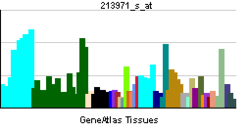SUZ12
Polycomb protein SUZ12 is a protein that in humans is encoded by the SUZ12 gene.[1][2][3][4] This zinc finger gene has been identified at the breakpoints of a recurrent chromosomal translocation reported in endometrial stromal sarcoma. Recombination of these breakpoints results in the fusion of this gene and JAZF1. The protein encoded by this gene contains a zinc finger domain in the C terminus of the coding region. The specific function of this gene has not yet been determined.[4]
SUZ12, as part of Polycomb Repressive Complex 2 (PRC2), may be involved with chromatin silencing in conjunction with HOTAIR ncRNA, using its zinc-finger domain to bind the RNA molecule.[5]
References
- ↑ Nagase T, Seki N, Tanaka A, Ishikawa K, Nomura N (Mar 1996). "Prediction of the coding sequences of unidentified human genes. IV. The coding sequences of 40 new genes (KIAA0121-KIAA0160) deduced by analysis of cDNA clones from human cell line KG-1". DNA Res 2 (4): 167–74, 199–210. doi:10.1093/dnares/2.4.167. PMID 8590280.
- ↑ Koontz JI, Soreng AL, Nucci M, Kuo FC, Pauwels P, van Den Berghe H, Dal Cin P, Fletcher JA, Sklar J (May 2001). "Frequent fusion of the JAZF1 and JJAZ1 genes in endometrial stromal tumors". Proc Natl Acad Sci U S A 98 (11): 6348–53. doi:10.1073/pnas.101132598. PMC 33471. PMID 11371647.
- ↑ Ross PJ, Ragina NP, Rodriguez RM, Iager AE, Siripattarapravat K, Lopez-Corrales N, Cibelli JB (Dec 2008). "Polycomb gene expression and histone H3 lysine 27 trimethylation changes during bovine preimplantation development". Reproduction 136 (6): 777–85. doi:10.1530/REP-08-0045. PMID 18784248.
- ↑ 4.0 4.1 "Entrez Gene: SUZ12 suppressor of zeste 12 homolog (Drosophila)".
- ↑ Rinn JL; Kertesz M; Wang JK et al. (June 2007). "Functional Demarcation of Active and Silent Chromatin Domains in Human HOX Loci by Non-Coding RNAs". Cell 129 (7): 1311–23. doi:10.1016/j.cell.2007.05.022. PMC 2084369. PMID 17604720. Retrieved 2010-07-20.
Further reading
- Birve A; Sengupta AK; Beuchle D et al. (2001). "Su(z)12, a novel Drosophila Polycomb group gene that is conserved in vertebrates and plants". Development 128 (17): 3371–9. PMID 11546753.
- Weinmann AS; Bartley SM; Zhang T et al. (2001). "Use of Chromatin Immunoprecipitation To Clone Novel E2F Target Promoters". Mol. Cell. Biol. 21 (20): 6820–32. doi:10.1128/MCB.21.20.6820-6832.2001. PMC 99859. PMID 11564866.
- Cao R; Wang L; Wang H et al. (2002). "Role of histone H3 lysine 27 methylation in Polycomb-group silencing". Science 298 (5595): 1039–43. doi:10.1126/science.1076997. PMID 12351676.
- Kuzmichev A; Nishioka K; Erdjument-Bromage H et al. (2002). "Histone methyltransferase activity associated with a human multiprotein complex containing the Enhancer of Zeste protein". Genes Dev. 16 (22): 2893–905. doi:10.1101/gad.1035902. PMC 187479. PMID 12435631.
- Strausberg RL; Feingold EA; Grouse LH et al. (2003). "Generation and initial analysis of more than 15,000 full-length human and mouse cDNA sequences". Proc. Natl. Acad. Sci. U.S.A. 99 (26): 16899–903. doi:10.1073/pnas.242603899. PMC 139241. PMID 12477932.
- Petek E; Jenne DE; Smolle J et al. (2003). "Mitotic recombination mediated by the JJAZF1 (KIAA0160) gene causing somatic mosaicism and a new type of constitutional NF1 microdeletion in two children of a mosaic female with only few manifestations". J. Med. Genet. 40 (7): 520–5. doi:10.1136/jmg.40.7.520. PMC 1735521. PMID 12843325.
- Wang H; An W; Cao R et al. (2003). "mAM facilitates conversion by ESET of dimethyl to trimethyl lysine 9 of histone H3 to cause transcriptional repression". Mol. Cell 12 (2): 475–87. doi:10.1016/j.molcel.2003.08.007. PMID 14536086.
- Huang HY, Ladanyi M, Soslow RA (2004). "Molecular detection of JAZF1-JJAZ1 gene fusion in endometrial stromal neoplasms with classic and variant histology: evidence for genetic heterogeneity". Am. J. Surg. Pathol. 28 (2): 224–32. doi:10.1097/00000478-200402000-00010. PMID 15043312.
- Cao R, Zhang Y (2004). "SUZ12 is required for both the histone methyltransferase activity and the silencing function of the EED-EZH2 complex". Mol. Cell 15 (1): 57–67. doi:10.1016/j.molcel.2004.06.020. PMID 15225548.
- Kehrer-Sawatzki H; Kluwe L; Sandig C et al. (2004). "High Frequency of Mosaicism among Patients with Neurofibromatosis Type 1 (NF1) with Microdeletions Caused by Somatic Recombination of the JJAZ1 Gene". Am. J. Hum. Genet. 75 (3): 410–23. doi:10.1086/423624. PMC 1182020. PMID 15257518.
- Beausoleil SA; Jedrychowski M; Schwartz D et al. (2004). "Large-scale characterization of HeLa cell nuclear phosphoproteins". Proc. Natl. Acad. Sci. U.S.A. 101 (33): 12130–5. doi:10.1073/pnas.0404720101. PMC 514446. PMID 15302935.
- Pasini D; Bracken AP; Jensen MR et al. (2004). "Suz12 is essential for mouse development and for EZH2 histone methyltransferase activity". EMBO J. 23 (20): 4061–71. doi:10.1038/sj.emboj.7600402. PMC 524339. PMID 15385962.
- Gerhard DS; Wagner L; Feingold EA et al. (2004). "The Status, Quality, and Expansion of the NIH Full-Length cDNA Project: The Mammalian Gene Collection (MGC)". Genome Res. 14 (10B): 2121–7. doi:10.1101/gr.2596504. PMC 528928. PMID 15489334.
- Cha TL; Zhou BP; Xia W et al. (2005). "Akt-mediated phosphorylation of EZH2 suppresses methylation of lysine 27 in histone H3". Science 310 (5746): 306–10. doi:10.1126/science.1118947. PMID 16224021.
- Lee TI; Jenner RG; Boyer LA et al. (2006). "Control of developmental regulators by Polycomb in human embryonic stem cells". Cell 125 (2): 301–13. doi:10.1016/j.cell.2006.02.043. PMID 16630818.
- Furuno K; Masatsugu T; Sonoda M et al. (2006). "Association of Polycomb group SUZ12 with WD-repeat protein MEP50 that binds to histone H2A selectively in vitro". Biochem. Biophys. Res. Commun. 345 (3): 1051–8. doi:10.1016/j.bbrc.2006.05.014. PMID 16712789.
- Olsen JV; Blagoev B; Gnad F et al. (2006). "Global, in vivo, and site-specific phosphorylation dynamics in signaling networks". Cell 127 (3): 635–48. doi:10.1016/j.cell.2006.09.026. PMID 17081983.
- Nucci MR; Harburger D; Koontz J et al. (2007). "Molecular analysis of the JAZF1-JJAZ1 gene fusion by RT-PCR and fluorescence in situ hybridization in endometrial stromal neoplasms". Am. J. Surg. Pathol. 31 (1): 65–70. doi:10.1097/01.pas.0000213327.86992.d1. PMID 17197920.

